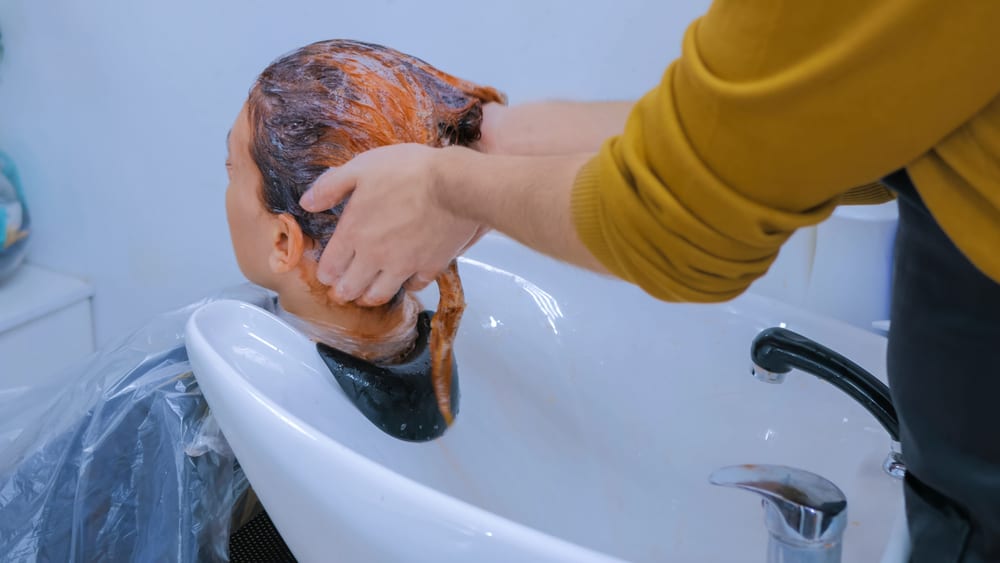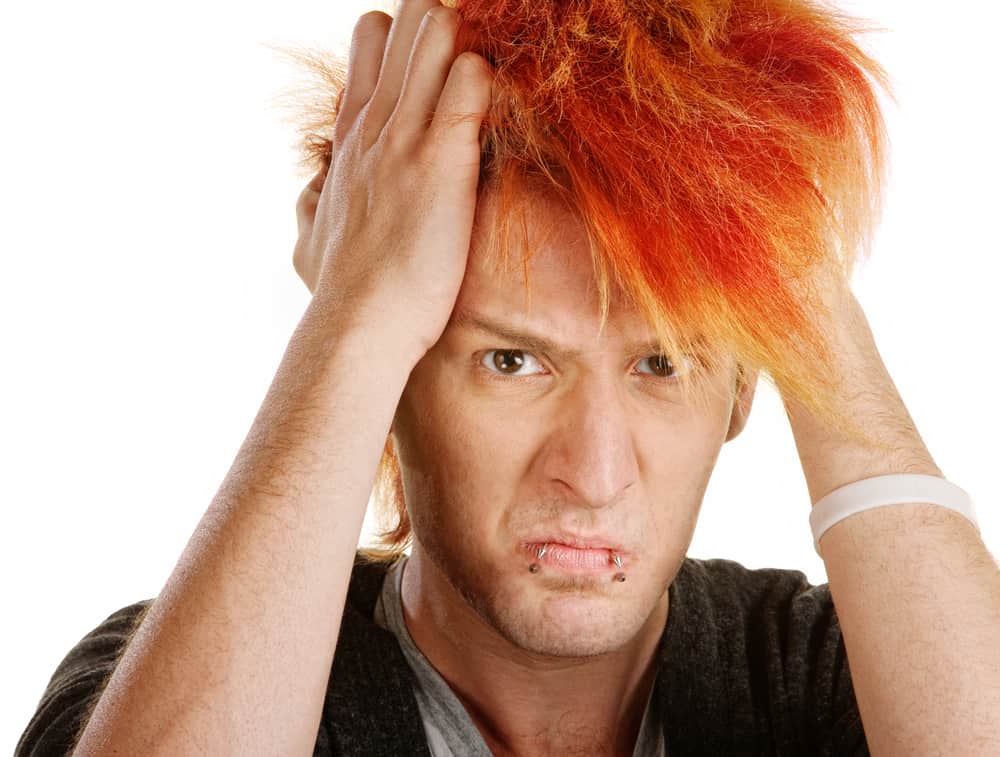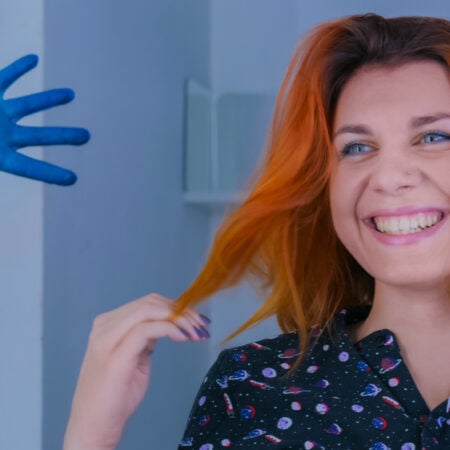Sudden orange hair can be every DIY color enthusiast’s nightmare, especially if you were aiming to turn your hair into the flawless platinum blonde of your dreams. Orange is one of the most stubborn pigments to remove from hair, hence why it is so common to experience various shades of orange when lightening or otherwise coloring your hair.
Fortunately, there are several ways to fix orange hair and create a natural-looking style that doesn’t have any hints of orange in it. Read on to find out the potential reasons behind your orange locks, what you can do to get rid of orange hair, and some pro tips to help you care for color-treated hair.
Reasons Your Hair Turned Orange
Your hair could have turned orange for any number of reasons, especially if this is your first time trying to create a DIY hair color (it can be a hard process to get right!). We’ve listed some of the most common causes for orange hair below.
Fading Dye
One of the simplest reasons for your hair having turned orange is due to the presence of a fading hair dye, typically one that was initially a dark red or rich auburn color. If you notice your hair looking strikingly orange one day, think back to the last time you dyed it, as this may be the culprit.
Keep in mind that if you do have permanent color in your hair, you may want to use a color remover to get the rest of the dye out of your hair before attempting to fix the orange color. Removing the excess pigment will give you the most even base possible, potentially preventing any further hair disasters.
Bleaching Mishap
Bleaching hair is a difficult process to get right, especially if you are doing it at home or you are attempting it for the first time.
There are several things that can go wrong with a bleaching process that can result in you ending up with orange hair, including rinsing out the bleach too early, not saturating your hair with enough bleach, not using a quality bleach, or not using the right volume of developer.
If you are determined to bleach your hair at home, consider watching this video first to ensure you get the steps down correctly and prevent the appearance of any orange hair.
Starting With a Dark Base
Sometimes, no matter how well you apply your bleach, you will end up with orange hair as a sort of in-between step.
This is much more common with hair that is super dark to start with, as it takes a lot more to lighten this hair color and fully remove every pigment from the strands; orange is the most stubborn color to remove, which is why your hair turns orange after the first bleaching session on your journey to turn dark hair blonde.
How to Fix Your Orange Hair
There are a few different methods you can use to fix your orange hair. Below, we’ve listed the most effective solutions and a step-by-step guide for how to achieve each one.
Understand the Color Wheel
When figuring out the best way to fix your orange hair, it is important to understand the color wheel; the color wheel will help you determine which colors cancel out orange and brassy tones so you can make a more informed decision about toners or dyes to select and possible tinted shampoos to purchase.
On a basic color wheel, you can look at the color directly opposite your hair’s color (whether that be orange, red-orange, or yellow-orange). This opposite color will be the best shade to cancel out the orange tones in your hair; it will be a shade of blue, because blue cancels out orange tone. If you are going to tone your hair or use a tinted conditioner, a blue hue is the one you want to use for maximum results.
Additionally, darker colors tend to have more orange pigments, which you can learn more about by reading color theory basics. If you are trying to cover up your orange hair with a dye, it is better to go for a darker rich brown color, as this is the most likely to cover up your orange hair without creating an unwanted gross murky color instead.
Apply a Toner
If your hair has ended up a lighter orange after bleaching or as the result of a fading dye, you can try and apply a darker colored toner over the top of it. Because there is a lot of orange in darker hair colors, you should be able to safely tone your orange hair to a light or medium brown color, or even a beige blonde color, depending on how light the orange is.
If your goal is to just remove orange and see what color the rest of your hair takes, you should use a completely blue-colored toner.
Regardless of which color toner you need, we recommend using this brand, as it is easy to use and there is a large amount of toning color variety available.
Steps
Once you have selected your toner, you should apply it to your hair carefully in order to reduce the orange color.
- Before you begin your application, your hair should be damp, but not soaking wet. This will help your help dilute the color just a little bit so that it doesn’t appear too vibrant. If you really want to go for maximum color, you can apply the toner to dry hair instead.
- Mix your toner with the proper developer amount, either 10 volume, if you don’t want to risk any hair lightening, or 20 volume, if you want to get a little bit of color lift in your hair.
- After your toner mixture is ready, section out your hair into four areas. Go section by section and use gloved hands or a dye brush to fully saturate the mid-lengths and ends of your hair.
- Once the mid-lengths and ends are completely saturated with toner, you can apply the mixture to your roots, making sure not to overlap too much onto your mid-lengths.
- You should check the color of your hair after about 10 minutes to see if it has reached the desired level. If it hasn’t, leave it on another 10 minutes (according to the instructions on the toner box), and then rinse it out with cool water.
- Air dry your hair to check the final color and then style as you see fit!
Keep in mind that you can tone your hair a second time if you didn’t get the color results you wanted on the first time. If a second toner doesn’t solve the issue however, you may have a more complex underlying problem causing your orange hair that should be dealt with by a professional.
Dye It Darker
A fairly foolproof way to cover up orange hair is to dye it darker. When using this method, choose a dye that has a warm brown color or reddish tones in it, as that will cover up the orange the most.
We also recommend using a professional color, because that will give you the most vibrant results and has a higher chance of completely covering the orange tones of your hair.
Steps
You can follow our basic hair dye steps to achieve darker hair, but be sure to read the instructions on whichever brand of dye you purchase to avoid any hair mishaps.
- You should be applying your hair dye on completely dry hair, preferably hair that hasn’t been washed in the past 24 hours. This will allow the natural oils on your scalp to protect you from potential irritation.
- Prepare your dye according to directions. Many box dye kits will come with everything you need included, or you can purchase professional dye and other materials separately.
- Section your hair out into at least four sections, more if your hair is especially thick or coarse.
- Begin applying the dye at your roots (you can start at the roots only if you are dyeing darker!) and then work it down the mid-lengths and ends. Apply the dye section by section, taking care that the dye is evenly applied and fully saturating your hair.
- Leave the dye on for the recommended amount of time, and then rinse it off with cool water. You can then air dry your hair and style it as you like.
Remember that you should avoid washing your hair with shampoo for at least 24 hours after you have dyed it to give enough time for color pigments to truly settle into your hair; this will provide your hair with the most vibrant and long-lasting color possible.
Lighten It Further
If you’ve discovered that your hair has turned orange instead of your desired blonde color, the best solution is to perform another round of bleaching on your hair, lightening your locks and getting rid of the orange color.
Steps
Bleaching your hair multiple times can be seriously damaging to it, so if possible, wait several days all the way up to two weeks before attempting to lighten it again.
If this isn’t possible, use the lowest developer you can and be sure to apply hydrating treatments in the weeks following the bleaching.
- Prepare your hair for another round of bleaching by adding some hydrating treatments onto it and not washing it within 24 hours of your planned bleaching day. This will help repair some of the damage from the last process and leave natural oils on your scalp to help protect your hair during the current process.
- Mix your bleach and developer together (20 or 30 volume is recommended) and section your hair out into small sections. You should also prepare foils for your hair if you started out with very dark hair, as foiling will make the bleach more effective.
- Separate small chunks of hair from each section and begin by applying your bleach to the mid-lengths and ends of your hair. Fully saturate the hair and apply extra bleach to places that are very dark orange. If needed, put your bleached hair in foils before moving onto the next section.
- Work like this around your head, moving from the bottom back of your hair to the top and front.
- Once all of your mid-lengths and ends have been covered in bleach, apply the bleach to your roots, again working from the bottom back up to the front and top of your head.
- After all of your hair is saturated in bleach, you can cover your hair with a plastic bag, if you are not using foils. This helps heat up your head and makes the bleaching more effective.
- Check your hair regularly to ensure that it is lightening properly and is not becoming too light in any areas. Once you’ve left on the bleach the recommended amount of time, rinse it out with cool water and then shampoo and condition your hair.
After you’ve washed and dried your hair (we recommend air drying to prevent further hair damage), look closely at the color. Any remaining light orange or yellow hues can be removed using a toner (see above), but if you have very dark orange spots left, you may want to do a light touch up with bleach. Be careful during any touch-ups as your hair is likely already very compromised, and you don’t want to overlap onto other strands, causing patchiness.
If your hair is still incredibly orange after a second bleaching, you may want to consider seeing a professional to fix the color, or just using a toner at home to see if that takes down the orange a little bit.
Remember that bleaching is an incredibly difficult process to get right, especially if you are doing it yourself, and there is no shame in finding a stylist to help you fix up your hair.

Caring for Your Treated Hair
After you’ve bleached, toned, or redyed your hair, your locks are sure to be drier and more damaged than they were before. These tips for caring for treated hair can help you regain back some vibrancy in your tresses.
Hydrating Treatments
Hydrating hair treatments, either store-bought or homemade, are the perfect thing to add moisture back into your hair and fight any frizziness that comes along with having treated hair. You can use a hydrating treatment once every other week for best results.
Tinted Conditioners
If you decided to fully lighten your hair and go blonde to fix an orange color, it is a good idea to invest in a tinted shampoo or conditioner; keep in mind that conditioner will be more hydrating to damaged hair.
These products will either be purple or blue, and you can select which color you would like based on the tones you are trying to neutralize in your hair. For cooler, white blondes, we suggest purple conditioner, and for beige, medium blondes, we suggest a blue conditioner.
Color Upkeep
Once your hair is treated, it is a good idea to periodically redye or re-tone it. This process typically only needs to be done every 4 to 8 weeks, depending on the color and type of dye you are using.
Consistent color upkeep combined with hydrating treatments is the best way to keep your hair looking vibrant and soft.
Bond Builders
Bond builders are hair care products designed to repair your hair from the inside out. The ingredients in such products work to repair strands, leaving your hair looking shinier, feeling softer, and appearing much less frizzy.

Reaching Your Desired Style
Experiencing unexpected orange hair is never a fun situation to be in, especially if you are DIYing your hair and have never received orange locks before.
Fortunately, there are several ways to fix orange hair, so as long as you stay calm and select the option that is best suited to your hair goals and current situation, you will soon be on your way to removing the orange color and reaching your desired hair style.
